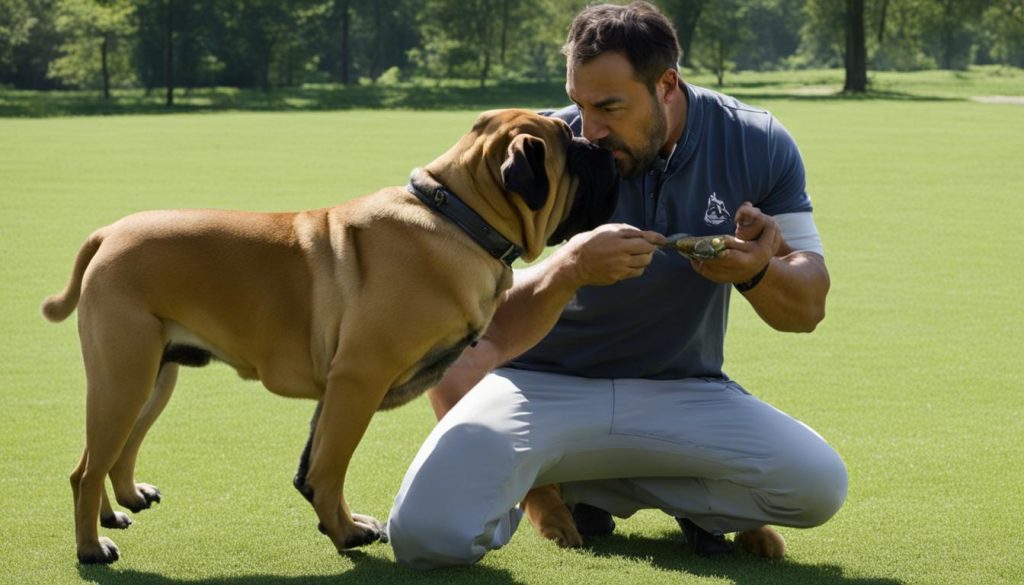Training your Bullmastiff is crucial for fostering good behavior and a harmonious bond. In this comprehensive guide, I will share with you valuable tips and techniques to ensure your Bullmastiff becomes a well-mannered and obedient companion. From obedience training to behavioral training, we will explore effective methods that will strengthen your bond and promote proper socialization.
Bullmastiff Training
- Bullmastiff training is essential for a well-behaved and obedient companion.
- Effective communication through positive reinforcement is vital in training Bullmastiffs.
- Using voice commands and hand gestures is highly effective in obedience and behavioral training.
- Recognize and avoid common mistakes that can hinder your Bullmastiff’s training progress.
- Troubleshoot behavioral problems promptly with consistent training and positive reinforcement.
Common Mistakes in Bullmastiff Training
When it comes to Bullmastiff training, many owners unknowingly make common mistakes that can lead to destructive behavior in their dogs. It’s important to recognize and avoid these mistakes to ensure a positive and successful training experience with your Bullmastiff.
1. Not providing the proper tools for training
One common mistake is not having the right tools for training your Bullmastiff. Investing in a sturdy leash, a well-fitting collar or harness, and appropriate training treats can make a significant difference in your training sessions. These tools help you effectively communicate with your Bullmastiff and reinforce desired behaviors.
2. Using outdated training methods
Traditional training methods that rely on dominance and punishment can be counterproductive and lead to destructive behavior in Bullmastiffs. Instead of using force or physical corrections, opt for positive reinforcement techniques. Rewarding desired behaviors with treats, praise, and play encourages your Bullmastiff to repeat those behaviors in the future and creates a more positive training environment.
3. Failing to address behavior problems early on
Ignoring or neglecting to address behavior problems in the early stages can escalate them into more serious issues. It’s important to address any unwanted behaviors promptly and consistently. Whether it’s excessive barking, chewing, or jumping, addressing these behaviors with appropriate training techniques helps redirect your Bullmastiff’s energy and establish boundaries.
To prevent destructive behavior in your Bullmastiff, it’s crucial to provide them with the right tools, use positive reinforcement techniques, and address behavior problems early on. By avoiding these common mistakes, you can set a solid foundation for your Bullmastiff’s training and foster a well-behaved and obedient companion.
The Importance of Effective Communication
Effective communication plays a crucial role in Bullmastiff training. It is a key factor in establishing a strong bond between you and your furry friend, enabling you to achieve training success. Unfortunately, many traditional training methods rely on outdated principles that hinder effective communication between dogs and their owners.
These outdated methods often involve force, domination tactics, and the use of painful tools such as choke and prong collars. Not only can these techniques cause fear and anxiety in Bullmastiffs, but they also fail to foster positive communication and trust.
Instead, I recommend using positive reinforcement and clear communication to effectively train your Bullmastiff. Positive reinforcement involves rewarding desired behaviors with treats, praise, or play, which encourages your dog to repeat those behaviors. This method promotes a positive and enjoyable training experience for both you and your Bullmastiff.
Clear communication is equally important in Bullmastiff training. By using consistent voice commands and hand gestures, you can effectively convey your expectations to your dog. This clear communication helps your Bullmastiff understand what is expected of them and builds a foundation of trust and mutual understanding.
Using outdated training methods not only hinders effective communication but can also strain the relationship between you and your Bullmastiff. Instead, embrace positive reinforcement and clear communication to establish a harmonious training environment that promotes learning, trust, and mutual respect.

Listed below are the key benefits of effective communication in Bullmastiff training:
- Promotes a strong bond and trust between you and your Bullmastiff
- Enhances your Bullmastiff’s understanding of your expectations
- Reduces fear, anxiety, and stress during training sessions
- Makes training a positive and enjoyable experience for both you and your Bullmastiff
- Establishes a foundation for effective obedience and behavioral training
By prioritizing effective communication and utilizing positive reinforcement techniques, you can create a training experience that is both rewarding and successful for you and your Bullmastiff.
Training Techniques for Bullmastiffs
When it comes to training Bullmastiffs, a combination of voice commands, hand gestures, and positive reinforcement is highly effective. Obedience training plays a vital role in teaching your Bullmastiff basic commands and manners, such as sitting, staying, and coming when called. By consistently using voice commands accompanied by hand gestures, you can enhance communication with your Bullmastiff and reinforce their understanding of the desired behavior.
In obedience training, positive reinforcement is key. Rewarding your Bullmastiff with treats, praise, or playtime when they perform the desired behavior helps create a positive association and motivates them to continue obeying your commands. This positive reinforcement technique encourages good behavior and strengthens the bond between you and your furry friend.
Behavioral training is another essential aspect of Bullmastiff training. It focuses on correcting unwanted behaviors like excessive barking, chewing, and jumping. Identify the root causes of these behaviors and use appropriate training methods to address them effectively. For instance, redirecting your Bullmastiff’s chewing behavior towards appropriate chew toys can help prevent destructive chewing.
Consistency and patience are crucial throughout the training process. Set a regular training schedule and dedicate time each day to work with your Bullmastiff. Be patient with them as they learn and progress at their own pace. Remember that training is an ongoing process, and it requires repetition and reinforcement to solidify the desired behaviors.
By utilizing these training techniques – voice commands, hand gestures, positive reinforcement, obedience training, and behavioral training – you can successfully train your Bullmastiff and cultivate good behavior. Building a strong foundation of obedience and proper behavior will result in a well-mannered and obedient companion for years to come.

Troubleshooting Behavioral Problems
Bullmastiffs, like any other dog breed, can sometimes develop behavioral problems that require careful attention and troubleshooting. It is crucial to address these issues promptly to prevent them from becoming ingrained habits and affecting your Bullmastiff’s overall well-being. By understanding key training principles and employing effective techniques, you can successfully troubleshoot common behavioral problems and help your Bullmastiff progress in their training.
One common behavioral problem that Bullmastiffs may exhibit is digging. This behavior can be addressed by providing appropriate outlets for your dog’s energy, such as designated digging areas filled with sand or soil, where they can indulge their natural instincts without destroying your garden or yard.
Separation anxiety is another issue that Bullmastiffs may experience. This can manifest in excessive barking, destructive chewing, or attempts to escape when left alone. By gradually acclimating your Bullmastiff to being alone for short periods of time and using positive reinforcement techniques, such as leaving them with a special treat or toy, you can help alleviate their anxiety and promote a sense of security.
Destructive chewing is yet another behavioral problem that Bullmastiffs may exhibit, especially during their teething phase. It is crucial to provide appropriate chew toys and redirect their chewing behavior towards them. Additionally, ensuring that your Bullmastiff has plenty of exercise and mental stimulation can help alleviate this problem.
Remember, consistency is key when troubleshooting behavioral problems. By setting clear boundaries, providing positive reinforcement when your Bullmastiff exhibits desired behaviors, and redirecting unwanted behaviors with firm but gentle correction, you can help shape their behavior and continue making progress in their training.
Conclusion
Training your Bullmastiff is a rewarding experience that requires time, patience, and dedication. By following the tips and techniques outlined in this Bullmastiff training guide, you can establish a strong bond with your furry friend and achieve training success. Remember to communicate effectively, use positive reinforcement, and troubleshoot any behavioral problems that may arise. With consistent training, your Bullmastiff will become a well-mannered and obedient companion for life.
The key to successful Bullmastiff training lies in using effective training methods and techniques. By utilizing positive reinforcement, clear communication through voice commands and hand gestures, and addressing any behavioral problems early on, you can shape your Bullmastiff’s behavior and ensure a harmonious relationship.
Investing time and effort in your Bullmastiff’s training is the key to developing a well-behaved and obedient companion. It is important to remember that training is an ongoing process that requires consistency and patience. By incorporating the valuable insights shared in this guide, you can create a positive and enjoyable training experience for both you and your Bullmastiff. With dedication and the right training approach, you can unlock your Bullmastiff’s full potential and enjoy a lifelong bond based on trust and obedience.
FAQ
Why is Bullmastiff training important?
Bullmastiff training is essential for ensuring that your furry friend becomes a well-mannered and obedient companion.
What are common mistakes in Bullmastiff training?
Common mistakes in Bullmastiff training can include not providing the proper tools for training and using outdated training methods.
How can I effectively communicate with my Bullmastiff?
Effective communication with your Bullmastiff can be achieved through positive reinforcement and clear communication using voice commands and hand gestures.
What techniques should I use for training my Bullmastiff?
Training techniques for Bullmastiffs include using voice commands, hand gestures, and positive reinforcement, focusing on obedience and behavioral training.
How can I troubleshoot behavioral problems in my Bullmastiff?
To troubleshoot behavioral problems in your Bullmastiff, understanding key training principles and techniques is important, along with consistent training and positive reinforcement.
What is the key to training success?
The key to training success lies in establishing a strong bond with your Bullmastiff, using effective training methods, and addressing behavioral problems promptly.






